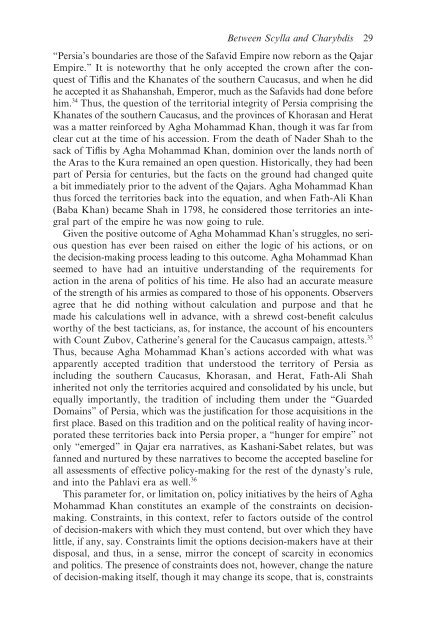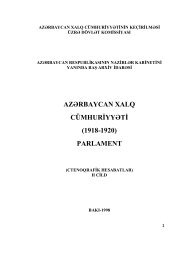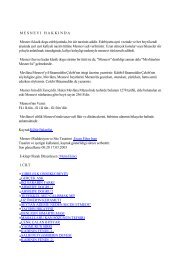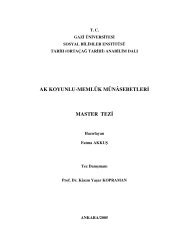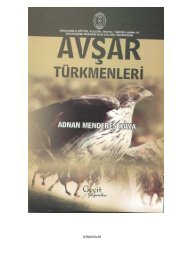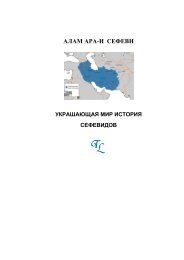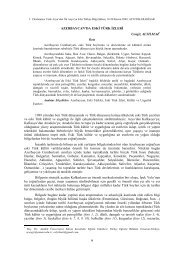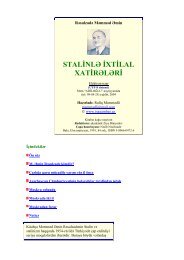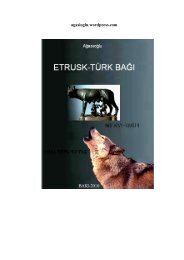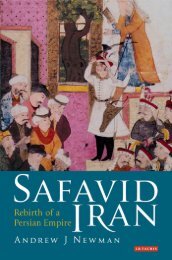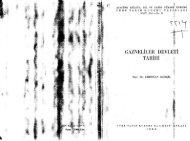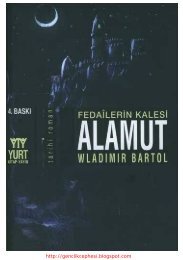War and Peace in Qajar Persia: Implications Past and ... - Oguzlar.az
War and Peace in Qajar Persia: Implications Past and ... - Oguzlar.az
War and Peace in Qajar Persia: Implications Past and ... - Oguzlar.az
- No tags were found...
Create successful ePaper yourself
Turn your PDF publications into a flip-book with our unique Google optimized e-Paper software.
Between Scylla <strong>and</strong> Charybdis 29“<strong>Persia</strong>’s boundaries are those of the Safavid Empire now reborn as the <strong>Qajar</strong>Empire.” It is noteworthy that he only accepted the crown after the conquestof Tiflis <strong>and</strong> the Khanates of the southern Caucasus, <strong>and</strong> when he didhe accepted it as Shahanshah, Emperor, much as the Safavids had done beforehim. 34 Thus, the question of the territorial <strong>in</strong>tegrity of <strong>Persia</strong> compris<strong>in</strong>g theKhanates of the southern Caucasus, <strong>and</strong> the prov<strong>in</strong>ces of Khorasan <strong>and</strong> Heratwas a matter re<strong>in</strong>forced by Agha Mohammad Khan, though it was far fromclear cut at the time of his accession. From the death of Nader Shah to thesack of Tiflis by Agha Mohammad Khan, dom<strong>in</strong>ion over the l<strong>and</strong>s north ofthe Aras to the Kura rema<strong>in</strong>ed an open question. Historically, they had beenpart of <strong>Persia</strong> for centuries, but the facts on the ground had changed quitea bit immediately prior to the advent of the <strong>Qajar</strong>s. Agha Mohammad Khanthus forced the territories back <strong>in</strong>to the equation, <strong>and</strong> when Fath-Ali Khan(Baba Khan) became Shah <strong>in</strong> 1798, he considered those territories an <strong>in</strong>tegralpart of the empire he was now go<strong>in</strong>g to rule.Given the positive outcome of Agha Mohammad Khan’s struggles, no seriousquestion has ever been raised on either the logic of his actions, or onthe decision-mak<strong>in</strong>g process lead<strong>in</strong>g to this outcome. Agha Mohammad Khanseemed to have had an <strong>in</strong>tuitive underst<strong>and</strong><strong>in</strong>g of the requirements foraction <strong>in</strong> the arena of politics of his time. He also had an accurate measureof the strength of his armies as compared to those of his opponents. Observersagree that he did noth<strong>in</strong>g without calculation <strong>and</strong> purpose <strong>and</strong> that hemade his calculations well <strong>in</strong> advance, with a shrewd cost-benefit calculusworthy of the best tacticians, as, for <strong>in</strong>stance, the account of his encounterswith Count Zubov, Cather<strong>in</strong>e’s general for the Caucasus campaign, attests. 35Thus, because Agha Mohammad Khan’s actions accorded with what wasapparently accepted tradition that understood the territory of <strong>Persia</strong> as<strong>in</strong>clud<strong>in</strong>g the southern Caucasus, Khorasan, <strong>and</strong> Herat, Fath-Ali Shah<strong>in</strong>herited not only the territories acquired <strong>and</strong> consolidated by his uncle, butequally importantly, the tradition of <strong>in</strong>clud<strong>in</strong>g them under the “GuardedDoma<strong>in</strong>s” of <strong>Persia</strong>, which was the justification for those acquisitions <strong>in</strong> thefirst place. Based on this tradition <strong>and</strong> on the political reality of hav<strong>in</strong>g <strong>in</strong>corporatedthese territories back <strong>in</strong>to <strong>Persia</strong> proper, a “hunger for empire” notonly “emerged” <strong>in</strong> <strong>Qajar</strong> era narratives, as Kashani-Sabet relates, but wasfanned <strong>and</strong> nurtured by these narratives to become the accepted basel<strong>in</strong>e forall assessments of effective policy-mak<strong>in</strong>g for the rest of the dynasty’s rule,<strong>and</strong> <strong>in</strong>to the Pahlavi era as well. 36This parameter for, or limitation on, policy <strong>in</strong>itiatives by the heirs of AghaMohammad Khan constitutes an example of the constra<strong>in</strong>ts on decisionmak<strong>in</strong>g.Constra<strong>in</strong>ts, <strong>in</strong> this context, refer to factors outside of the controlof decision-makers with which they must contend, but over which they havelittle, if any, say. Constra<strong>in</strong>ts limit the options decision-makers have at theirdisposal, <strong>and</strong> thus, <strong>in</strong> a sense, mirror the concept of scarcity <strong>in</strong> economics<strong>and</strong> politics. The presence of constra<strong>in</strong>ts does not, however, change the natureof decision-mak<strong>in</strong>g itself, though it may change its scope, that is, constra<strong>in</strong>ts


